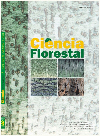
|
Ciência Florestal
Centro de Pesquisas Florestais - CEPEF, Departamento de Ciências Florestais - DCFL, Programa de Pós Graduação em Engenharia Florestal - PPGEF
ISSN: 0103-9954
EISSN: 0103-9954
Vol. 16, No. 4, 2006, pp. 357-367
|
 Bioline Code: cf06032
Bioline Code: cf06032
Full paper language: Portuguese
Document type: Research Article
Document available free of charge
|
|
|
Ciência Florestal, Vol. 16, No. 4, 2006, pp. 357-367
| pt |
DINÂMICA DA ESTRUTURA DA COMUNIDADE DE LAURÀCEAS NO PERÍODO 1995-2004 EM UMA FLORESTA DE ARAUCÀRIA NO SUL DO ESTADO DO PARANÀ, BRASIL
de Góes Canalez, Geise; Corte, Ana Paula Dalla & Sanquetta, Carlos Roberto
Resumo
Várias espécies da família Lauraceae estão entre as mais comuns na Floresta de Araucária. Elas possuem bom potencial silvicultural e econC4mico, mas são pouco estudadas. Este trabalho trata das mudanças estruturais no período 1995-2004 de oito espécies da família Lauraceae ocorrentes em um fragmento florestal localizado no centro-sul do estado do Paraná. As espécies foram analisadas pelos indicadores estruturais e dinâmicos: IVI, abundância, área basal, volume, distribuição diamétrica, distribuição espacial, recrutamento, mortalidade e incrementos. Os resultados demonstraram que, em 10 anos de dinâmica estrutural, a família Lauraceae, de maneira geral, manteve inalterada sua posição de importância na comunidade. Observou-se que as Lauráceas passam por aumento de densidade, porque o recrutamento está sendo maior que a mortalidade. Já o crescimento das Lauráceas tem sido muito baixo, tanto em diâmetro como em área basal e volume. Embora a maior parte das Lauráceas apresente um padrão dinâmico lento, algumas espécies passam por um intenso processo de mudanças, como é o caso da canela-amarela (Nectandra grandiflora Nees & Mart. ex Nees), que aumentou a maioria dos seus indicadores estruturais e dinâmicos, constituindo-se na espécie de maior destaque entre as analisadas. Essa espécie apresenta recrutamento muito superior à mortalidade, distribuição diamétrica decrescente e ampla distribuição espacial. Esses elementos estão tornando essa espécie em uma das três mais importantes em toda a comunidade, juntamente com a araucária (Araucaria angustifolia (Bertol.) Kuntze) e a erva-mate (Ilex paraguariensis A.St.-Hil.). Concluiu-se que, em 10 anos, já é possível distinguir processos ecológicos importantes que podem servir como indicativos em Planos de Manejo para Florestas semelhantes de Araucária.
Palavras-chave
florestas de araucária; fitossociologia; dinâmica florestal; lauráceas.
|
| |
| en |
STRUCTURAL DYNAMICS OF THE LAURACEAE COMMUNITY DURING 1995-2004 IN AN ARAUCARIA FOREST, SOUTHERN PARANÀ STATE, BRAZIL
de Góes Canalez, Geise; Corte, Ana Paula Dalla & Sanquetta, Carlos Roberto
Abstract
Several species of Lauraceae family are among the most common ones in the Araucaria Forest. They have good silvicultural and economic potential, but unfortunately they are still very poorly studied. This paper analyzes the structural changes of eight species of Lauraceae family during 1995-2004 in a forest located in the center-south region of Parana State, Brazil. The species were investigated through structural and dynamic indicators: importance value (IVI), abundance, basal area, trunk volume, diameter distribution, spatial pattern, recruitment, mortality and increments. The results showed that the structural position of the Lauraceae family was kept almost unaltered in the community during the ten-year period. It was also noticed that the Lauraceae family is increasing in terms of abundance due to the fact that recruitment has been greater than mortality. However, growth rates have been very low, either in diameter and basal area/volume. Although most Lauraceae species show a slow dynamic behavior, some of them have experienced an intense chance process, such as Canela-amarela(Nectandra grandiflora Nees & Mart. ex Nees) which increased most of its structural and dynamic indicators, becoming the most remarkable species among all those studied. This species showed recruitment greater than mortality, a J-shaped diameter distribution and very wide spatial distribution. These elements have turned this species one of the three most important in the community together with Araucaria angustifolia (Bertol.) Kuntze and Ilex paraguariensis A.St.-Hil. It was concluded that, in ten years, it is already possible to distinguish important ecological processes that may be very useful in formulating Management Plans for similar Araucaria forests.
Keywords
araucaria florest; phytosociology; forest dynamics; laurel trees.
|
| |
© Copyright 2006 - Ciência Florestal
Alternative site location: http://cascavel.ufsm.br/revistas/ojs-2.2.2/index.php/cienciaflorestal/index
|
|
